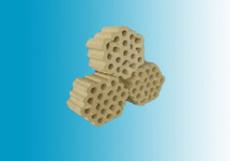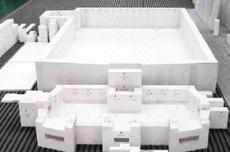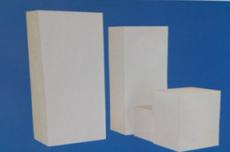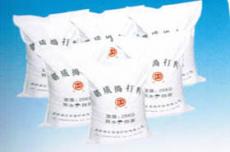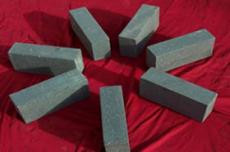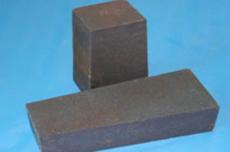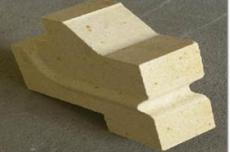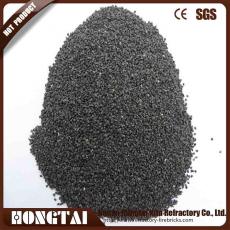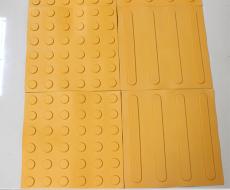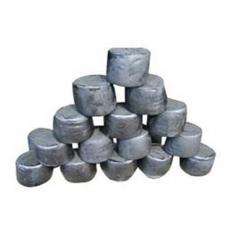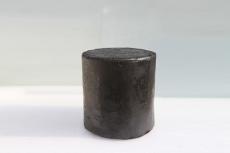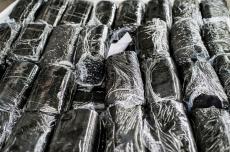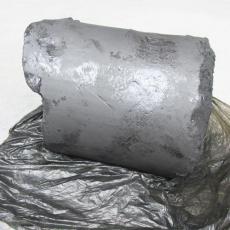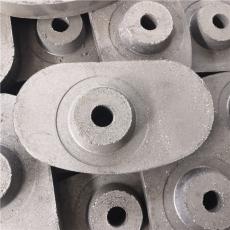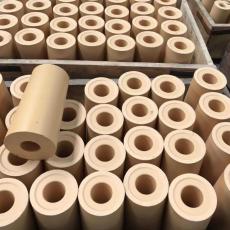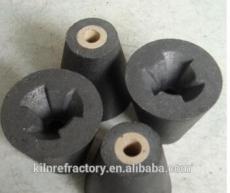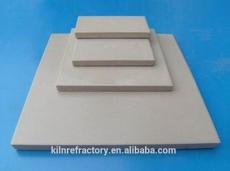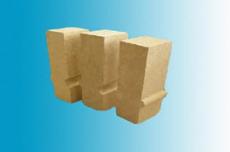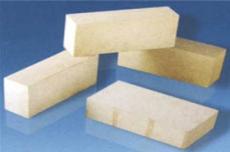
Silica molybdenum bricks are refractory bricks made of mullite, andalusite, silicon carbide and special-grade homogenized alumina as the main raw materials, and are formed by high-pressure molding and high-temperature firing. Silica molybdenum brick is a common refractory material, usually used in the lining of high-temperature industrial equipment, such as cement rotary kilns.
Silica molybdenum bricks have a variety of excellent performance characteristics
Silica molybdenum bricks have a variety of excellent performance characteristics. Its density, strength and wear resistance are significantly better than high alumina bricks and magnesia-alumina spinel bricks, and it has good results in the secondary firing zone and transition zone of cement rotary kilns. Different brands of silica molybdenum bricks have different load softening temperatures and different application parts. Their load softening temperatures are usually above 1500°C, and some are as high as 1690°C. They can withstand the high temperature impact in the kiln without softening or deformation. Silica molybdenum bricks contain a certain amount of SiC. SiC has high thermal conductivity and relatively small thermal expansion coefficient, which significantly improves the thermal stability of the product. The 1100°C water cooling test has been more than 10 times, up to 46 times, so it is used in cement rotary kilns. It does not peel or break when used for a long time, which significantly improves the service life. In addition, silica molybdenum bricks also have good thermal insulation properties. In terms of composition, silica molybdenum bricks not only contain silicon carbide and mullite, but also raw materials such as special-grade homogenized alumina. Therefore, the statement "it is a high-grade refractory brick made of materials such as silicon carbide and mullite" is not comprehensive and accurate enough.
The right choice of silica molybdenum bricks
Silica molybdenum bricks are refractory bricks made of mullite, andalusite, silicon carbide and special-grade homogenized alumina as the main raw materials, and are formed by high-pressure molding and high-temperature firing. It is not only made of materials such as silicon carbide and mullite, but also includes special-grade homogenized alumina. Silica molybdenum brick is a common refractory material, usually used in the lining of high-temperature industrial equipment, such as cement rotary kilns. It has a unique set of performance characteristics that make it important in specific industrial applications. Silica molybdenum bricks may have some subtle differences in different industries and application scenarios, but generally speaking, their core components and basic production processes are relatively stable. For example, in the steel industry, in order to cope with the high temperature and strong alkaline corrosive environment during pretreatment in hot metal tanks, silicone bricks are used; in the cement industry, silicone bricks can perform well in different parts of the rotary kiln.
Detailed explanation of the composition of silica molybdenum bricks
The main components of silica molybdenum bricks include mullite, andalusite, silicon carbide and special-grade homogenized alumina. Mullite is a mineral with good refractory properties and can withstand high temperatures. Andalusite helps improve the thermal stability of the brick. Silicon carbide has high hardness, high wear resistance and good thermal conductivity, which can enhance the overall performance of silicon molybdenum bricks. Special grade homogenized bauxite provides the necessary basic ingredients and structural support for silica molybdenum bricks. When different manufacturers produce silica molybdenum bricks, they may fine-tune the proportions of these ingredients based on specific needs and processes. For example, some manufacturers may increase the content of silicon carbide to improve the wear resistance of silica mullite bricks; while some manufacturers may pay more attention to the content of mullite to enhance its fire resistance.
Advantages of silica molybdenum bricks
Silica molybdenum bricks have a variety of excellent performance characteristics. First of all, its density, strength and wear resistance are significantly better than high alumina bricks and magnesia-alumina spinel bricks, and it has good results in the secondary firing zone and transition zone of cement rotary kilns. Secondly, different brands of silica molybdenum bricks have different load softening temperatures, which are usually above 1500°C, and some are as high as 1690°C. They can withstand the impact of high temperatures in the kiln without softening or deformation. In addition, silicon molybdenum bricks contain a certain amount of SiC. SiC has high thermal conductivity and relatively small thermal expansion coefficient, which significantly improves the thermal stability of the product. The 1100°C water cooling test has exceeded 10 times, up to 46 times, so it is used in cement. It does not peel or break when used in rotary kilns, which significantly increases the service life. At the same time, silica molybdenum bricks also have good thermal insulation properties. These performance advantages make silica molybdenum bricks have broad application prospects in high-temperature industrial environments and can meet various stringent usage requirements.
Application of Silica Molybdenum Bricks in Cement Rotary Kiln
Silica molybdenum bricks are widely used in cement rotary kilns. Except for the approximately 20m long firing zone that uses directly bonded magnesia bricks and the front and rear kiln mouths that each use about 0.8m of castables, the current cement transition zone is almost entirely made of silica molybdenum bricks.
The rear part of the firing zone, that is, the secondary firing zone, is difficult to stabilize the kiln skin when using directly bonded magnesia bricks. Due to the poor thermal shock stability and low wear resistance of magnesia bricks, the joint between the bricks and the kiln skin is easy to peel off with the kiln skin, which greatly affects the service life of the transition zone. Due to its good thermal shock stability, silica molybdenum bricks do not break or peel during use, are corrosion-resistant, and have a significantly longer service life. For example, many companies' 2500t/d cement rotary kiln 21.55m~24.95m uses directly bonded magnesia-chromium bricks, with a service life of 310 days, but instead uses silica-molybdenum bricks (AZM1650), with a service life of 410 days. There are also 2500t/d cement rotary kilns that originally used magnesia-alumina spinel bricks in the secondary firing zone and anti-flaking high-alumina bricks in the transition zone. They had to be repaired and replaced as many as three times in a year, with the shortest occurring in three months. Red kiln. The kiln lining was reconfigured, and the secondary firing zone was changed to 1680 silica molybdenum bricks, and the transition zone was 1650 silica molybdenum bricks. The service life of the kiln was as long as 15 months.
Comparison between silica molybdenum bricks and other refractory bricks
Compared with high-alumina silicon carbide bricks, silica molybdenum bricks have different compositions. High alumina silicon carbide bricks use high alumina clinker, gray corundum and silicon carbide sand and silicon carbide powder with high SiC content as raw materials, and pulp waste liquid is used as the binding agent. The main crystal phase of silicon mullite bricks is composed of silicon carbide, mullite and corundum with high hardness.
In terms of fire resistance, high alumina silicon carbide bricks have good slag resistance, fire resistance and heat resistance because they contain silicon carbide and other components. The load softening temperature of silicon molybdenum bricks is above 1500°C, and some are as high as 1690°C. They can withstand high temperature impact in the kiln without softening or deformation. In terms of use, high alumina silicon carbide bricks are often used in metallurgy, chemical industry, glass and other industrial fields. Silica molybdenum bricks are mainly used in the transition zone, cooling zone, kiln mouth and other parts of cement kilns. Compared with magnesia-alumina spinel bricks, silica-molybdenum bricks have differences in density, strength, thermal conductivity, etc. Silica molybdenum bricks have higher density, higher strength and relatively lower thermal conductivity; magnesia-alumina spinel bricks have lower density, lower strength and better thermal conductivity.
Silicon molybdenum bricks get firing process
The firing process of silica molybdenum brick is relatively complicated. The main raw materials include high alumina clinker, brown corundum, silicon carbide, etc. Choosing corundum and silicon carbide to strengthen the matrix is the prerequisite for the product to have high volume density, high thermal strength, corrosion resistance and wear resistance. The additive aluminum oxide powder is introduced to improve the high-temperature performance of the product. The binder is pulp waste liquid with a density of 1.20~1.25g/cm, and the addition amount is 3%-4%.
During the firing process, the required raw materials must be accurately weighed in a reasonable proportion. The particle size composition is based on the principle of "large at both ends and small in the middle". In order to ensure the uniformity of the matrix, the fine powder material is pre-mixed evenly with a spiral mixer to make a mixed powder, and then aluminum oxide powder is added. The various materials are prepared and put into the mixer. After dry mixing, the sulfurous acid pulp waste liquid is added to continue. Mix evenly, and then press it into 230mm×114mm×65mm standard bricks and 50mm×50mm cylindrical samples under a 630t press. After drying, they are fired in an electric furnace at 1420°C and kept warm for 3 hours.
The composition of silica molybdenum brick is complex, and its performance advantages make it widely used in high-temperature industrial equipment such as cement rotary kilns. Compared with other refractory bricks, silica molybdenum bricks have their own characteristics in terms of composition, performance and use. Its firing process is also relatively strict and precise to ensure that its quality and performance meet the requirements.
